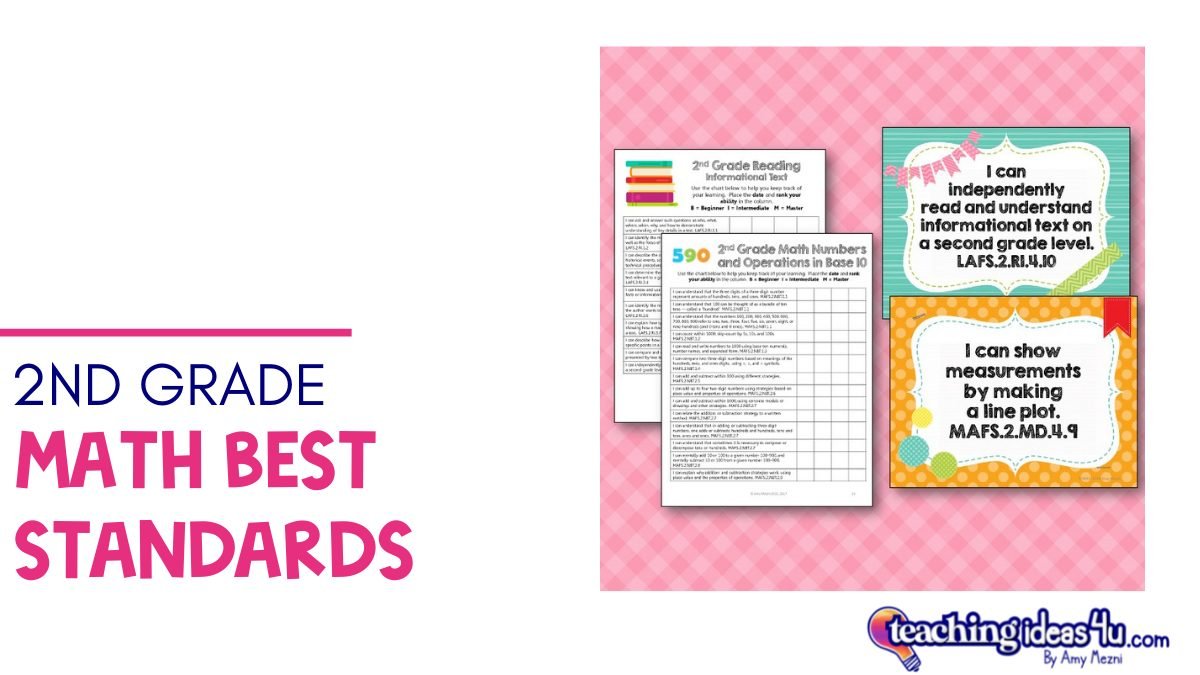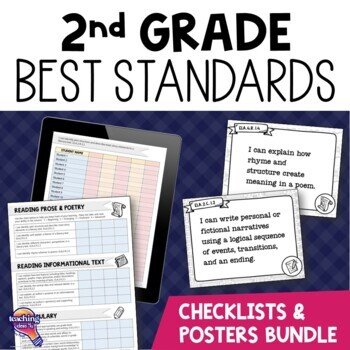2nd Grade Math BEST Standards
What can second-grade teachers expect from the new Florida BEST Standards for math? How do they compare to the MAFS standards? What are second-grade students now expected to learn?
Set your mind at ease, because I am going to break down the new second-grade Math BEST standards. In this post, I will quickly analyze the changes and how they will affect your classroom.
How are the BEST Standards organized?
In second grade, Math BEST standards are divided into 7 subcategories, while the MAFS had 5:
Number Sense and Operations - Previously Numbers and Operations in Base 10
Measurement
Data Analysis and Probability – These standards were split into their own category. They were previously in Measurement and Data
Algebraic Reasoning – Was Operations and Algebraic Thinking
Geometric Reasoning – Previously Geometry
Fractions – In MAFS, these standards were under Geometry.
Mathematical Practice – This is now called Mathematical Thinking and Reasoning. These are the global standards students are expected to use throughout their school career.
The Changes
Honestly, there are not many major changes to the math standards. A lot of the updates feel like changes in wording more than an actual change in concepts taught.
For ease of organization, I am going to discuss the new standards by subcategory.
Mathematical Thinking & Reasoning
These standards are the overarching skills students are meant to improve throughout their math classes.
The word precision was changed to fluency (MA.K12.MTR.3.1 - Complete tasks with mathematical fluency.)
The big changes are in what was removed:
“Create models with mathematics.”
“Select and use appropriate mathematical tools strategically.”
More discussion on these two things later. These two standards seem to tie into many of the standards that either had their wording changed or were omitted in BEST.
Number Sense and Operations
The core concepts taught in this category basically stayed the same. There is only one new addition: MA.2.NSO.1.4 – Round whole numbers from 0 to 100 to the nearest 10.
Although some of the language has changed, the bulk of the other standards really teach the same concepts.
There are a few concepts that are no longer in BEST. MAFS Standards that were removed:
2.NBT.1.2 – Count within 1000; skip-count by 5s, 10s, and 100s.
2.NBT.2.6 – Add up to four two-digit numbers using strategies based on place value and properties of operations.
2.NBT.2.7 – This standard said “Add and subtract within 1000.” All of the “extra” language regarding using concrete models and other strategies was removed, including “relate the addition or subtraction strategy to a written method.” This is an example of how the Mathematical Practice standards were changed, and the other subcategories edited to fit those changes.
2.NBT.2.9 – Explain why addition and strategies work, using place value and the properties of operations.
Algebraic Reasoning
Again, there are some slight changes in this subcategory but nothing major.
The only new standards I saw were:
2.AR.2.1 – Determine and explain whether equations involving addition and subtraction are true or false. This is definitely new, as I could not find true and false referenced anywhere in MAFS.
2.AR.3.2 – Use repeated addition to find the total number of objects in a collection of equal groups. Although this is a new standard, it easily fits into the other standards around it.
The only major concept removed from this section is “know from memory all sums of two one-digit numbers by the end of second grade.”
Measurement
Measurement also has few surprises. A new standard, MA.2.M.2.1, adds “express portions of an hour using the fractional terms half an hour, half past, quarter of an hour, quarter after, and quarter til.” Although new, it really is just adding specific language to the time standards.
MAFS specified using a number line to represent whole numbers, whereas BEST just says “use an appropriate tool” and has a clarification that rulers and tape measures should also be used as number lines. (More on clarifications later.)
Data Analysis and Probability
These standards had been in a subcategory with Measurement in MAFS.
Line plots were removed from second grade. The other two standards in this area cover the same skills as those in MAFS. BEST just adds using tally marks and making tables in addition to pictographs and bar graphs.
Fractions
This is a new category in BEST, but these standards were previously part of Geometry. No changes in skills taught.
Geometry
Geometry is the one subcategory that seems to have major changes. Tiling is no longer mentioned in the second-grade standards.
Quite a few skills from third grade MAFs have been moved to second:
2.GR.1.2 – Categorize two-dimensional figures based on the number and length of sides, number of vertices, whether they are closed or not and whether the edges are curved or straight.
2.GR.1.3 – Identify line(s) of symmetry for a two-dimensional figure.
2.GR.2 – Describe perimeter and find the perimeter of polygons.
1 – Explore perimeter as an attribute of a figure by placing unit segments along the boundary without gaps or overlaps. Find perimeters of rectangles by counting unit segments.
2 – Find the perimeter of a polygon with whole-number side lengths. (Limited to triangles, rectangles, squares, and pentagons.)
Takeaways
Having more subcategories is just a change – not better or worse. Teachers will get used to them.
With the exception of Geometry, there are very few changes in skills taught, so teachers will not have to adjust that many math lessons. The ones that do need to be edited should not be that difficult to change to meet the new standards.
My general sense is that many standards were changed to be a more general and less specific. With the removal of models and using mathematical tools in the Mathematical Thinking and Reasoning, it felt like the general changes were to accommodate being allowed to use (or not use) different strategies.
Geometry seems to be moving standards down a grade level. Many skills moved from third to second, and I noticed movement in these standards in other grades, too.
One of my critiques is that the BEST standards for second grade removed some of the specific building blocks that help students understand the thinking and learn the vocabulary they will need in future grades, such as being able to explain why strategies work. However, teachers could easily continue to use these lessons, as they still fit under the general standards.
The Benchmark Clarifications are the cause of my other critique. While I appreciate having the standards clarified, there are so many of these clarifications. Nearly every standard has 1 – 3.
The reason these subpoints are necessary is the condensing of multiple MAFS standards into one BEST standard. While having fewer standards may be convenient, it is not easier to manage fewer standards if they have multiple addendums. Some of the clarifications are obvious, but teachers will have to pay close attention to others.
Overall, second-grade math teachers can breathe easy. The Math BEST standards should not be a difficult change from MAFS.
Standards Resources
My standards posters and checklists are being updated (and improved!) If you previously purchased my Florida Standards resources, you get the updates for free – just check your My Purchases area in TPT.


